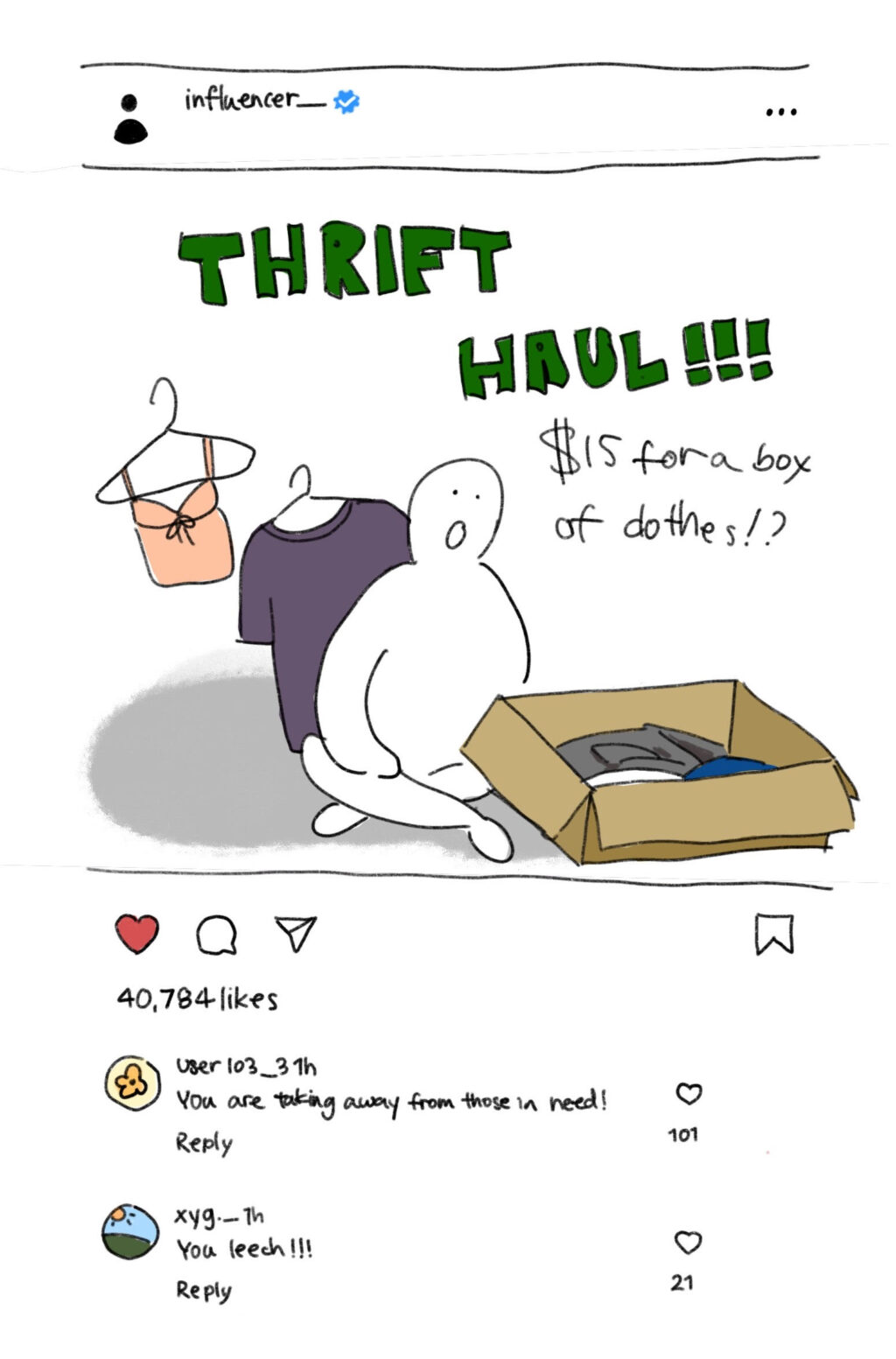
Amanda Zhu
The first time I told my mother I was off to Goodwill, she stared at me in confusion and bewilderment. Thrifting, for my mother, had always been synonymous with desperation, a last resort. But for me, living in the post-pandemic boom of thrift haul TikTok videos, shopping second-hand was simply a leisurely pursuit, a treasure hunt for the newest trend in vintage clothes.
In the age of fast fashion, thrifting may seem like a win-for-all situation: social media has sent hordes of teenagers to the cheap racks, in order to ‘reduce, reuse, recycle’ clothes. Yet, while its steadily increasing popularity encourages environmental awareness, it has also sparked much debate on the morality of second-hand shopping, fueling the emergence of “thrift store gentrification.” As a neighborhood becomes gentrified, the increasing presence of middle and upper-class shoppers prompts thrift stores to increase their prices, pushing out low-income buyers and those who shop second-hand out of necessity.
There is no doubt that these are legitimate concerns. Goodwill’s 2020 Valuation Guides reveal up to tripled prices compared to their 2010 items (not accounting for inflation), and many other thrift stores follow a similar pattern. I myself have encountered more than one tattered children’s shirt outrageously priced around five dollars, likely marketed as “vintage” in the hopes of enticing wealthier, trend-following customers.
In reality, however, increasing consumers and constant reselling cannot be blamed as the most significant culprits in thrift store inflation. While it’s true that demand leads to higher prices, what many are overlooking is the staggering excess of clothing that is produced and then overloaded into thrift stores every year. Only around 20% of clothes that are donated to these stores are actually sold to consumers. The rest are discarded or sent into an international resale market, putting financial pressure on local textile industries, who are unable to compete with the low prices of this clothing. Beyond that, general inflation, as well as increased operating costs like utilities, rent and wages, also contribute to rising thrift store prices.
Of course, some price jumps are so outrageous that they can’t be explained by America’s economy, which leads to fair criticism of such thrift stores. While companies like Goodwill are nonprofit, they are not exempt from corporate greed. Up until the pandemic, Goodwill employed many disabled individuals, which seemed charitable, but only paid them around $2.50 per hour until California banned disability subminimum wage programs. Today, thrift stores rack up revenue of around $14.2 billion, and Goodwill organizations’ presidents are paid an average of $600 thousand annually.
When discussing the ethics of thrifting, it’s important to realize that donating and shopping second-hand is not a good solution to America’s fast-fashion industry. Justifying the purchase of trendy new clothes by donating old ones simply reinforces the unsustainability of fast fashion, and treating thrift stores as a cheap and easy source of clothing only encourages overconsumption and the desire for an infinite closet.
However, shopping second-hand will always be better sustainability-wise than buying new, and although it’s not a perfect solution, increasing focus on thrifting can still help save the planet.
As the saying goes, “there’s no ethical consumption under capitalism,” but that doesn’t mean thrifters and resellers can’t be mindful and well-researched in what they’re buying or selling. Rather than buying clothes in bulk, thrifters and resellers can be conscious of the items they purchase, especially in consideration of those essential for people thrifting out of necessity, including formal wear, heavy winter clothes and school uniforms. Shopping with intention and discipline, while much harder than it seems, is crucial in avoiding the trap of low-cost clothing and escaping the cycle of overconsumption. For those who wish to go the extra mile, consider avoiding stores in low-income neighborhoods, and donating clothes to reputable and local organizations, whose profit will truly go to charity, and not into the pockets of an already wealthy business.




